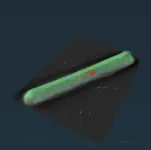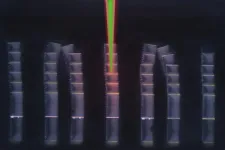(Press-News.org) **Strictly embargoed until 16:00 (BST) Wednesday 15 November 2023**
Scientists have observed a series of bright, brief flashes occurring months after a stellar explosion, known as a luminous fast blue optical transient, or LFBOT
The sighting of the never before seen flashes were made possible thanks to the University of Sheffield’s ULTRASPEC camera, mounted on the Thai National Telescope
Since their discovery in 2018, astronomers have speculated about what might drive such extreme explosions
Astrophysicists have settled the debate over the nature of a rare type of stellar explosion, thanks to a camera designed and built at the University of Sheffield.
Scientists have observed a series of bright, brief flashes occurring months after a stellar explosion, known as a luminous fast blue optical transient, or LFBOT.
One of the most crucial datasets for the research, published in Nature, was obtained with the University of Sheffield’s high-speed optical camera ULTRASPEC, mounted on the 2.4m Thai National Telescope. This showed that the repeated flares were as bright as the original explosion and yet each lasted only tens of seconds.
Since their discovery in 2018, astronomers have speculated about what might drive such extreme explosions, which are far brighter than the violent ends massive stars typically experience as supernovae. The research team believes the previously unknown flare activity they observed, and in particular their short timescale, confirms the engine of the LFBOT must be a stellar corpse - a black hole or neutron star.
Professor Vik Dhilon from the University of Sheffield’s Department of Physics and Astronomy who leads the ULTRACAM project, said: "Our high-speed camera ULTRASPEC was instrumental in the discovery of this incredible new type of stellar explosion, showing that the object emitted multiple supernova-strength optical flares that repeated on timescales of less than a minute, and all of this happened months after the initial explosion.
“This is unprecedented behaviour - most supernovae explode once and then steadily decline in brightness over the course of a few weeks until they disappear from view.
“The short timescale flares we observed imply that the engine driving the explosion is a small object - most likely a rapidly-spinning neutron star or an accreting black hole. This discovery teaches us more about the varied ways in which stars end their lives and the exotica that inhabit our Universe."
Anna Y. Q. Ho, Assistant Professor of Astronomy in the College of Arts and Sciences at Cornell University, said: “This settles years of debate about what powers this type of explosion, and reveals an unusually direct method of studying the activity of stellar corpses.
“We had never seen anything like that before – something so fast, and the brightness as strong as the original explosion months later – in any supernova or LFBOT. We’d never seen that in astronomy.
“Amazingly, instead of fading steadily as one would expect, the source briefly brightened again – and again, and again, LFBOTs are already a kind of weird, exotic event, so this was even weirder.”
Contact
For further information please contact: Alice Fletcher, Media and PR Assistant, University of Sheffield, alice.fletcher@sheffield.ac.uk, +44 114 222 1050
END
Astronomers discover signs of life in a star’s explosive death
The sighting of the never before seen flashes were made possible thanks to the University of Sheffield’s ULTRASPEC camera, mounted on the Thai National Telescope
2023-11-15
ELSE PRESS RELEASES FROM THIS DATE:
Fourth dose of COVID vaccine boosts protection in patients with rheumatic disease
2023-11-15
Patients with autoimmune rheumatic diseases, which include rheumatoid arthritis and other chronic disorders that cause inflammation, are at increased risk of SARS-CoV-2 infection, as well as death due to severe COVID-19. Many patients receive disease-modifying antirheumatic drugs (DMARDs) to treat these conditions, but this treatment has been associated with a blunted response to COVID-19 vaccines. The U.S. Centers for Disease Control and Prevention recommends that patients receiving DMARDs receive a fourth ...
MD Anderson research highlights for November 15, 2023
2023-11-15
HOUSTON ― The University of Texas MD Anderson Cancer Center’s Research Highlights showcases the latest breakthroughs in cancer care, research and prevention. These advances are made possible through seamless collaboration between MD Anderson’s world-leading clinicians and scientists, bringing discoveries from the lab to the clinic and back.
Recent developments at MD Anderson include insights into the role of RNA-binding proteins in DNA damage repair, the functional role of a hidden microprotein in regulating colorectal cancer gene expression, immunotherapy combinations in gynecologic cancers, the benefits of preventive exercise in protecting ...
Exposure to air pollution in utero may affect reproductive system development
2023-11-15
From invisible wafts of diesel exhaust to sun-choking plumes of orange smoke, air pollution is known to damage respiratory well-being. Now, research from Rutgers suggests another reason to hold our breath: Polluted air also may hurt reproductive health.
In a study of air pollution data in relation to markers of reproductive development in infancy, Rutgers researchers found certain pollutants may negatively alter anogenital distance, a measure of prenatal exposure to hormones.
“These findings suggest air ...
Novel C. diff structures are required for infection, offer new therapeutic targets
2023-11-15
Iron storage “spheres” inside the bacterium C. diff — the leading cause of hospital-acquired infections — could offer new targets for antibacterial drugs to combat the pathogen.
A team of Vanderbilt researchers discovered that C. diff (Clostridioides difficile) produces the spheres, called ferrosomes, and that these structures are important for infection in an animal model. The findings, reported Nov. 15 in the journal Nature, are also a rare demonstration of a membrane-bound structure inside a pathogenic bacterium.
Bacteria have long been thought not to contain organelles ...
UK diabetes prevention program may have global impact
2023-11-15
A nationwide programme to reduce the risk of developing diabetes in the UK is proven beyond reasonable doubt to work, a new study reveals.
The positive effects observed in the NHS Diabetes Prevention Programme – the largest such project in the world helping people across the UK to lose weight and control their blood sugar levels – may have relevance globally for tackling the diabetes epidemic.
The Diabetes Prevention Programme (NHS DPP) in England referred adults with high risk of developing diabetes to lifestyle counselling for losing weight, encouraging physical activity, and other ...
James Webb Space Telescope detects water vapor, sulfur dioxide and sand clouds in the atmosphere of a nearby exoplanet
2023-11-15
A team of European astronomers, co-led by researchers from the Institute of Astronomy, KU Leuven, used recent observations made with the James Webb Space Telescope to study the atmosphere of the nearby exoplanet WASP-107b. Peering deep into the fluffy atmosphere of WASP-107b they discovered not only water vapour and sulfur dioxide, but even silicate sand clouds. These particles reside within a dynamic atmosphere that exhibits vigorous transport of material.
Astronomers worldwide are harnessing the advanced capabilities of the Mid-Infrared Instrument (MIRI) aboard the James Webb Space Telescope (JWST) to conduct groundbreaking observations of exoplanets – planets orbiting stars ...
New laser setup probes metamaterial structures with ultrafast pulses
2023-11-15
Metamaterials are products of engineering wizardry. They are made from everyday polymers, ceramics, and metals. And when constructed precisely at the microscale, in intricate architectures, these ordinary materials can take on extraordinary properties.
With the help of computer simulations, engineers can play with any combination of microstructures to see how certain materials can transform, for instance, into sound-focusing acoustic lenses or lightweight, bulletproof films.
But simulations can only take a design so far. To know for sure whether a metamaterial will stand up to expectation, physically testing them is a must. But there’s been no reliable way to push and pull ...
Pulling the plug on brain injury: manipulating fluid flows could save lives, improve recovery post-TBI
2023-11-15
Cerebral edema, the dangerous brain swelling that occurs after traumatic brain injury (TBI), can increase risk of death tenfold and significantly worsen prospects for recovery in brain function. In extreme cases, surgeons will remove a portion of the skull to relieve pressure, but this has significant risks and is not viable for the vast majority of TBI cases. Physicians have very few tools at their disposal that are effective in treating cerebral edema, which is one of the leading causes of in-hospital deaths, and is associated with long-term neurological disability.
New ...
Completion of recommended tests and referrals in telehealth vs in-person visits
2023-11-15
About The Study: The findings of this study suggest that rates of completion for 4,133 diagnostic tests and referrals (colonoscopies, cardiac stress tests, and dermatology referrals) were low for all visit types but worse when ordered during telehealth visits. Failure to close diagnostic loops presents a patient safety challenge in primary care that may be of particular concern during telehealth encounters.
Authors: Maelys J. Amat, M.D., M.B.A., of Beth Israel Deaconess Medical Center in Boston, is the corresponding author.
To ...
Neighborhood disadvantage and autism spectrum disorder in a population with health insurance
2023-11-15
About The Study: Children residing in more disadvantaged neighborhoods at birth had higher likelihood of autism spectrum disorder (ASD) diagnosis in a study that included 318,000 children with health insurance. Future research is warranted to investigate the mechanisms behind the neighborhood-related disparities in ASD diagnosis, alongside efforts to provide resources for early intervention and family support in communities with a higher likelihood of ASD.
Authors: Daniel A. Hackman, Ph.D., of the University of Southern California in Los Angeles, is the corresponding author.
To access the embargoed study: Visit our For The Media website at this link https://media.jamanetwork.com/
(10.1001/jamapsychiatry.2023.4347)
Editor’s ...
LAST 30 PRESS RELEASES:
Researchers use robotics to find potential new antibiotic among hundreds of metal complexes
Gut bacteria changes at the earliest stages of inflammatory bowel disease
Scientists develop new way to “listen in” on the brain’s hidden language
Brain research: “Pulse generators” grow and shrink as memories are formed
For teens, any cannabis use may have impact on emotional health, academic performance
School meals could unlock major gains for human and planetary health
Menopause hormone therapy does not appear to impact dementia risk
Signature patterns of brain activity may help predict recovery from traumatic brain injury
Dresden study uncovers new key mechanism in cancer cells
New species are now being discovered faster than ever before, study suggests
Cannabis-based products show limited short-term benefit for chronic pain, with increased risk of adverse effects
Cannabis products with more THC slightly reduce pain but cause more side effects
Clearing the brain of aging cells could aid epilepsy and reduce seizures
Brain injuries linked with potential risk of suicide, new study finds
New technique lights up where drugs go in the body, cell by cell
New study finds movement of fishing fleets can reveal shifts in marine ecosystems
Embargoed: New evidence points to potential treatment for vascular dementia
Study uncovers disrupted brain balance in alcohol dependence
Working in groups can help Republicans and Democrats agree on controversial content moderation online
Structural findings reveal how distinct GPCR ligands create different levels of activation
Anything-goes “anyons” may be at the root of surprising quantum experiments
UC review: Maximizing workplace opportunity for veterans
From generation to complex control: Metasurfaces make perfect vortex beams "within reach"
Thin-film lithium niobate-based detector: recent advances and perspectives
Exploring why some people may tend to persistently make bad choices
How cells balance their protein levels
Nirsevimab vs RSVpreF vaccine for RSV–related hospitalization in newborns
Effectiveness and impact of maternal RSV immunization and nirsevimab on medically attended RSV in US children
AI gives scientists a boost, but at the cost of too many mediocre papers
Next-generation vision model maps tree growth at sub-meter precision
[Press-News.org] Astronomers discover signs of life in a star’s explosive deathThe sighting of the never before seen flashes were made possible thanks to the University of Sheffield’s ULTRASPEC camera, mounted on the Thai National Telescope


